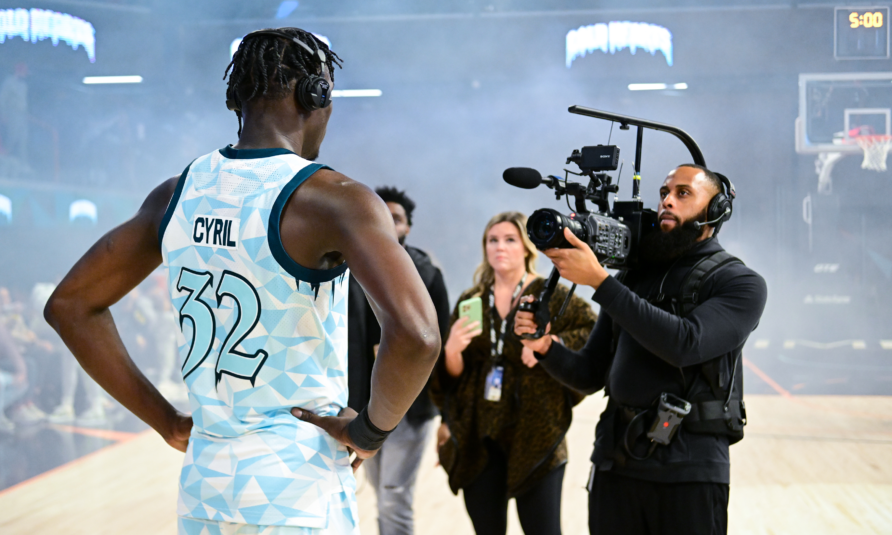Overtime, Prime Video Marry Live Broadcast With Social-Media Flavor For Live-Streamed Coverage of Overtime Elite Basketball
OTE semifinals stream on Prime Video on Friday night; final will stream March 3-4
Story Highlights
As a live-sports producer, what would you do if you had no limitations?
Access has been the industry’s mantra for some time in this and, through the years, has taken on different meanings. Where can we get a camera? What behind-the-scenes team activity will a franchise or league allow us to film?
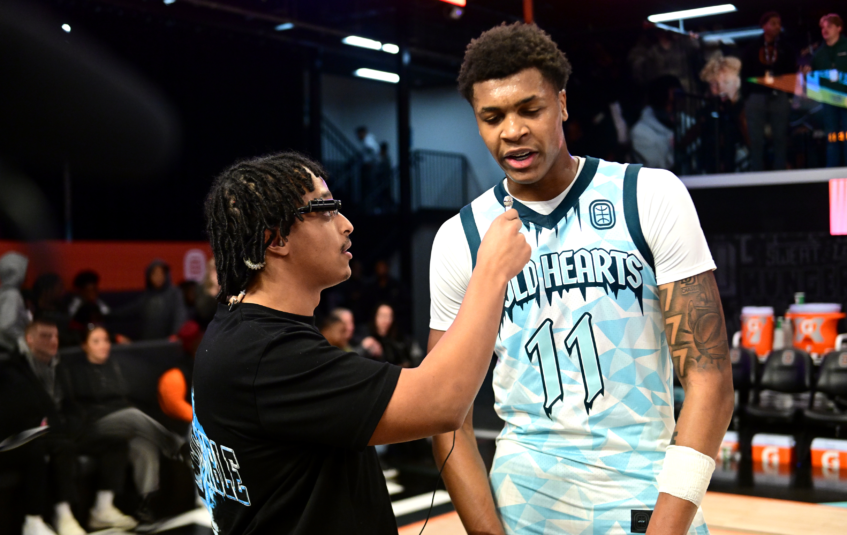
YouTube AMP personality and gamer Agent 00 (left) interviews OTE’s Cold Hearts forward Tyler Smith using a small microphone and a POV camera affixed to his glasses. (All photos: Overtime Elite/Adam Hagy)
Lately, in the live-game environment, “access” has been less about the visuals and more about the sound. Where can we get a league to allow us to place a microphone? How can we persuade the league to allow us to air raw audio live for the audience? Can we talk to a player while he or she is competing?
We’ve seen the line move dramatically on this topic over the past year. Look at ESPN’s and Fox Sports‘ live interviews of players during MLB games or the PGA TOUR’s use of ear buds to allow viewers to listen to caddie/golfer conversations and the commentators to freely speak with the golfer. And, of course, the inside access to replay review that broadcasts of the USFL and, most recently, the XFL have offered.
These developments aren’t enabled by technological advances (although there have been some). They have been made possible through the trust and relationships built between broadcast partners and the leagues, teams, and players they cover. At the end of the day, a major professional sports league is going to let a broadcaster go only so far. An old-school college-football head coach is not going to allow live cameras in the locker room when the team is down by 24 at the half. Leagues won’t allow salty arguments between players and officials to be aired unchecked.
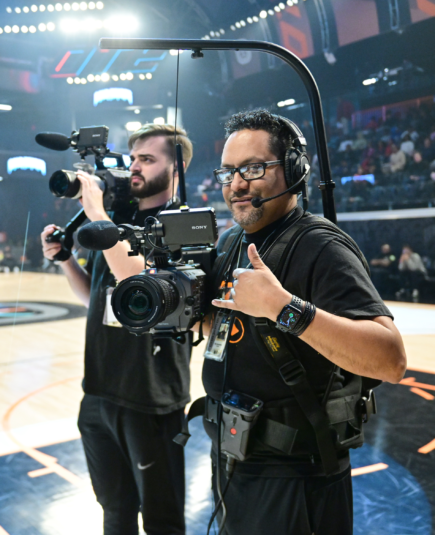
Overtime Elite camera operators Forest Roy (left) and Esly Hernandez work the court during a live game coverage. RF camera operators are regularly allowed to make their way onto the court during and between plays.
To go back to the original question, what if that relationship was invisible and you could do whatever you wanted? Next-gen sports brand Overtime is answering that question with live broadcasts of its high-energy youth basketball league Overtime Elite.
In a custom-built facility —resembling a basketball soundstage more than an arena — in Atlanta, OTE is taking advantage of the free range of a playing surface to put cameras in unique locations and place microphones literally anywhere to capture every intimate detail and exchange during a game.
“What’s so amazing is that we can be so fan-first,” says Marc Kohn, chief content officer, Overtime. “When we think about our broadcast, at its simplest terms, we put ourselves in the fan’s point of view. What do I want to see that I currently can’t get from a [major broadcaster]? Their broadcasts are immaculate. You watch an NFL game; these broadcasts are stunning. We can’t have 100 cameras on the game. We can’t out-ESPN ESPN. We can’t out-Fox Fox. We have to get creative and innovate on what we can do that they can’t do.”
Overtime Elite (OTE) is a six-team basketball league featuring some of the country’s top 16- to 20-year-old players. The players are paid, receive training, and are showcased in a season-long format to prepare them for a college and/or professional career. It’s a unique environment whose core is shortform, social-content creation.
This year, however, has brought a new opportunity for the organization to bring full game broadcasts to Amazon Prime Video. Games produced and delivered to Prime Video via a direct fiber line are exposing the social-first, shortform-video sports property to a new set of sports viewers and is establishing its own flavor of live game broadcast: any player’s, coach’s, or official’s conversation can be aired live; game commentators are popular YouTube personalities; and cameras can zip all around the arena. For Overtime brass, it’s a utopian dream of the best of traditional broadcast blended with the best in trending social video.
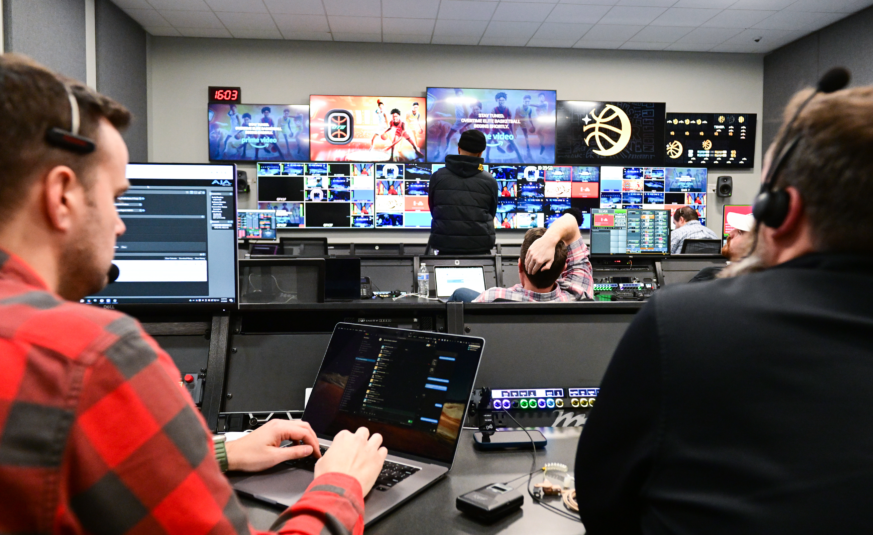
Engineer Scott Wynn (left) works in Overtime’s control room in its Atlanta facility, where the live-streamed games are produced and shipped to Prime Video via fiber.
“What we’ve done really well, I think, is mix the high-end television-production cameras with our social and visual voice,” says Kohn. “If you see our graphics package, it looks young. It looks like it’s built for the TikTok generation and the Instagram generation. The difference is, you’ll see a lot of television producers produce for a younger audience. We generally have people in their 20s that are doing all the design work going into these graphics. When we produce a 30-second package, sometimes, we’ll use vertical video that’ll look exactly like what would be seen on TikTok or Instagram. We’re building it natively for TikTok and then using those assets inside the broadcast.”
Live games are produced by Overtime from a centralized control room in its Atlanta facility and are overseen by Kohn, as well as Overtime Head of Production and Technology Matt Montemayor and Executive Producer Matt Fogarty. Bernard Worrell is executive producer of live games; K.J. Hammond is game producer; Garrett Hall, director and TD; and Scott Wynn is Engineer.
Games feature several segments and technologies that produce a unique basketball-viewing experience. A roving RF-camera operator and on-camera reporter will regularly make their way onto the court between plays to spontaneously interview a coach, a player, even an official. That’s Ref Cam. During free throws, the broadcast will go to a split screen of the player shooting and their shoes — a nod to Overtime’s social-media standing as a top sneaker account on TikTok. That’s called “OT Kicks Cam.”
Reporters will wear tiny lipstick cameras affixed to their glasses during on-court interviews. Boom-mic operators will extend over a huddle, enabling the broadcast to share the play being drawn up by the coaching staff. A two-point wired aerial camera flies the length of the court directly over its center. Kohn calls it the “2K Cam” because its angle resembles the backcourt live angle that gamers are used to playing from on the NBA 2K videogame series.
“What [Overtime is] trying to do is exciting because you see something that is unique,” says Ken Miller, director, live content production and operations, Prime Video, a longtime veteran of sports TV who joined Amazon following a career at Fox Sports and, most recently, Denver-based RSN Altitude Sports. “It is based on showmanship and showing off the athletes. They are also [attracting] the young viewer. They are going straight to the TikTok, YouTube, Instagram consumers when you look at their following. Those are going to be the next wave of people subscribing to Prime.”
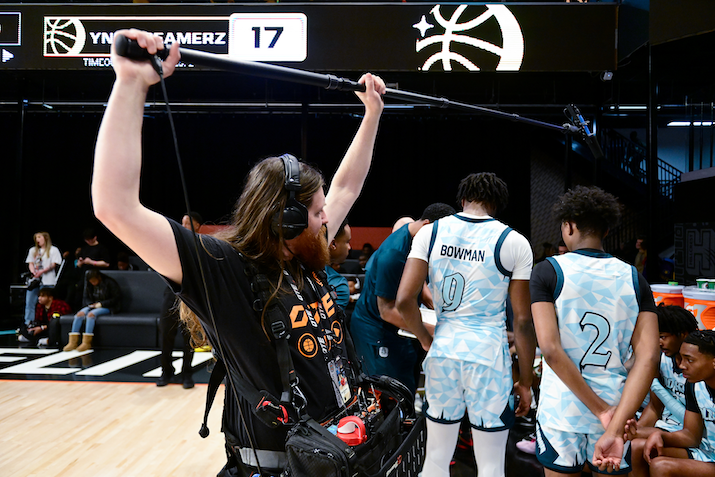
Boom-mic operator Matt Dunaway captures audio from a Cold Hearts huddle. Live audio from coaches and players are regularly woven into live broadcasts of Overtime Elite games.
Prime Video announced an official rights deal with Overtime Elite just days before the start of the regular season in early November. Now, with the semifinals set for tomorrow and the finals for next weekend (March 3-4), Season 1 of the distribution partnership is nearly in the books.
“This is just Year One, and we see such an opportunity to help grow this,” says Miller. “Can we grow the technology budget and add more cameras? We signed this deal late with them, and they’ve done such a terrific job producing a high-quality live broadcast. They’re open, and we’re open.”
Prime Video’s three-season agreement gives the platform exclusive global streaming rights to 20 live games per season. For OTE, a brand built around social and shortform video, Prime Video is the property’s first global media-rights partner.
Although the live game broadcasts for Prime Video have added a whole new layer of production on a game night, Overtime has remained true to its social roots. Every game is still a flourishing content farm for platforms like TikTok and Instagram. Content creators and shooters are capturing footage on smartphones, and a buzzing replay room and social media office (affectionately referred to as “The Kitchen”) churn through a massive array of feeds from both the live broadcast and the social shooters.
According to Kohn, Overtime has developed its own proprietary iPhone technology that helps more easily ingest and sort all the feeds coming in from content capturers working across the facility. The control room also deploys replay technology from Evertz DreamCatcher.
As for the total OTE package on Prime Video, it’s hard to watch what these shows are doing weekly and not wonder what from an OTE broadcast might one day soon catch the eye of a major broadcaster and make its way into an NBA telecast. The initial version of the XFL forever changed NFL broadcasting. Can OTE do something similar for the NBA, a league that is already very progressive?
“We just know that that’s going to happen,” says Kohn. “It has happened to us for the last five years. We find a format, we find something that works, and then you see other broadcasters take those ideas. That’s a sign of flattery.
“But I don’t spend all day thinking about what other people are going to take from us,” he continues. “I think it makes us go back to the drawing board and come up with the next thing and stay a step ahead of everybody.”
